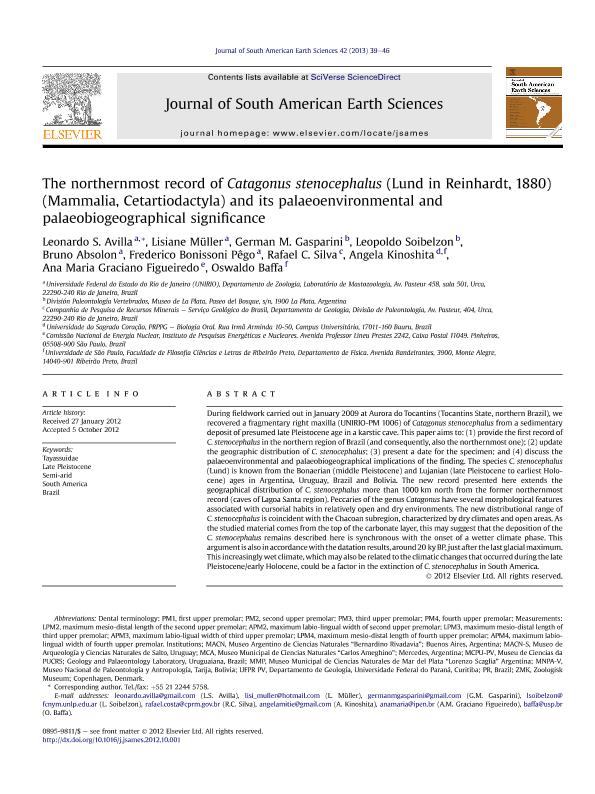Mostrar el registro sencillo del ítem
dc.contributor.author
Avilla, Leonardo S.
dc.contributor.author
Müller, Lisiana
dc.contributor.author
Gasparini, Germán Mariano

dc.contributor.author
Soibelzon, Leopoldo Héctor

dc.contributor.author
Absolon, Bruno
dc.contributor.author
Pêgo, Frederico Bonissoni
dc.contributor.author
Silva, Rafael C.
dc.contributor.author
Kinoshita, Angela
dc.contributor.author
Graciano Figueredo, Ana María
dc.contributor.author
Baffa, Oswaldo
dc.date.available
2017-08-31T20:12:29Z
dc.date.issued
2013-10
dc.identifier.citation
Avilla, Leonardo S.; Müller, Lisiana; Gasparini, Germán Mariano; Soibelzon, Leopoldo Héctor; Absolon, Bruno; et al.; The northernmost record of Catagonus stenocephalus (Lund in Reinhardt, 1880) (Mammalia, Cetartiodactyla) and its palaeoenvironmental and palaeobiogeographical significance; Elsevier; Journal of South American Earth Sciences; 42; 10-2013; 39-46
dc.identifier.issn
0895-9811
dc.identifier.uri
http://hdl.handle.net/11336/23387
dc.description.abstract
During fieldwork carried out in January 2009 at Aurora do Tocantins (Tocantins State, northern Brazil), we recovered a fragmentary right maxilla (UNIRIO-PM 1006) of Catagonus stenocephalus from a sedimentary deposit of presumed late Pleistocene age in a karstic cave. This paper aims to: (1) provide the first record of C. stenocephalus in the northern region of Brazil (and consequently, also the northernmost one); (2) update the geographic distribution of C. stenocephalus; (3) present a date for the specimen; and (4) discuss the palaeoenvironmental and palaeobiogeographical implications of the finding. The species C. stenocephalus (Lund) is known from the Bonaerian (middle Pleistocene) and Lujanian (late Pleistocene to earliest Holocene) ages in Argentina, Uruguay, Brazil and Bolivia. The new record presented here extends the geographical distribution of C. stenocephalus more than 1000 km north from the former northernmost record (caves of Lagoa Santa region). Peccaries of the genus Catagonus have several morphological features associated with cursorial habits in relatively open and dry environments. The new distributional range of C. stenocephalus is coincident with the Chacoan subregion, characterized by dry climates and open areas. As the studied material comes from the top of the carbonate layer, this may suggest that the deposition of the C. stenocephalus remains described here is synchronous with the onset of a wetter climate phase. This argument is also in accordance with the datation results, around 20 ky BP, just after the last glacial maximum. This increasingly wet climate, which may also be related to the climatic changes that occurred during the late Pleistocene/early Holocene, could be a factor in the extinction of C. stenocephalus in South America.
dc.format
application/pdf
dc.language.iso
eng
dc.publisher
Elsevier

dc.rights
info:eu-repo/semantics/openAccess
dc.rights.uri
https://creativecommons.org/licenses/by-nc-sa/2.5/ar/
dc.subject
Tayassuidae
dc.subject
Late Pleistocene
dc.subject
Semi-Arid
dc.subject
South America
dc.subject
Brasil
dc.subject.classification
Oceanografía, Hidrología, Recursos Hídricos

dc.subject.classification
Ciencias de la Tierra y relacionadas con el Medio Ambiente

dc.subject.classification
CIENCIAS NATURALES Y EXACTAS

dc.title
The northernmost record of Catagonus stenocephalus (Lund in Reinhardt, 1880) (Mammalia, Cetartiodactyla) and its palaeoenvironmental and palaeobiogeographical significance
dc.type
info:eu-repo/semantics/article
dc.type
info:ar-repo/semantics/artículo
dc.type
info:eu-repo/semantics/publishedVersion
dc.date.updated
2017-08-28T14:29:34Z
dc.journal.volume
42
dc.journal.pagination
39-46
dc.journal.pais
Países Bajos

dc.journal.ciudad
Ámsterdam
dc.description.fil
Fil: Avilla, Leonardo S.. Universidade Federal do Rio de Janeiro; Brasil
dc.description.fil
Fil: Müller, Lisiana. Universidade Federal do Rio de Janeiro; Brasil
dc.description.fil
Fil: Gasparini, Germán Mariano. Universidad Nacional de la Plata. Facultad de Ciencias Naturales y Museo. División Paleontología Vertebrados; Argentina. Consejo Nacional de Investigaciones Científicas y Técnicas; Argentina
dc.description.fil
Fil: Soibelzon, Leopoldo Héctor. Universidad Nacional de la Plata. Facultad de Ciencias Naturales y Museo. División Paleontología Vertebrados; Argentina
dc.description.fil
Fil: Absolon, Bruno. Universidade Federal do Rio de Janeiro; Brasil
dc.description.fil
Fil: Pêgo, Frederico Bonissoni. Universidade Federal do Rio de Janeiro; Brasil
dc.description.fil
Fil: Silva, Rafael C.. Companhia de Pesquisa de Recursos Minerais; Brasil
dc.description.fil
Fil: Kinoshita, Angela. Universidade do Sagrado Coração; Brasil. Universidade do Sao Paulo. Facultad de Filosofía, Letras e Ciencias Humanas; Brasil
dc.description.fil
Fil: Graciano Figueredo, Ana María. Comissao Nacional de Energia Nuclear.; Brasil
dc.description.fil
Fil: Baffa, Oswaldo. Universidade do Sao Paulo. Facultad de Filosofía, Letras e Ciencias Humanas; Brasil
dc.journal.title
Journal of South American Earth Sciences

dc.relation.alternativeid
info:eu-repo/semantics/altIdentifier/doi/http://dx.doi.org/10.1016/j.jsames.2012.10.001
dc.relation.alternativeid
info:eu-repo/semantics/altIdentifier/url/http://www.sciencedirect.com/science/article/pii/S0895981112001411
Archivos asociados
